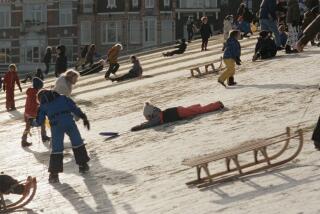EUROPE ’95 / Destination: Amsterdam : Touring Other Jewish Sites
- Share via
Though the Anne Frank House is the most popular and visible symbol of Jewish life in Amsterdam, several other sites offer a fascinating glimpse into the city’s Jewish history.
The great brown Portuguese Synagogue, built in 1675, and the nearby Jewish Historical Museum are both in the heart of former Jewish Amsterdam, in the neighborhood around Mr. Visserplein, southeast of the city center.
Among other things, you’ll learn that the synagogue is Portuguese because Sephardic Jews fled to Holland during the Spanish Inquisition, where they helped secure the city’s place in the world diamond trade. Later, fleeing Nazi persecution, Jews from Germany and elsewhere arrived. The Franks, for instance, were from Germany, where Anne was born.
The beautifully designed Jewish Historical Museum is also worth a visit. The photos, documents and descriptions of Jewish life as the Nazi noose closed offer a brutally vivid picture of what the Franks and their friends were hiding from.
A useful guide is “Jewish Amsterdam,” a pamphlet available in English from the Amsterdam Tourist Office, which has several branches around town. It contains a two-hour walking tour of the major sights, including a map, some historical information and transit instructions.
Don’t expect a lot of lighthearted fun: Many of the sights are landmarks in the history of human cruelty. The Hollandse Schowburg, for example, was Holland’s premier theater before the war and also happened to be Jewish-owned. The Nazis converted it into a staging facility for Jews facing deportation to concentration camps. Today, it is open to the public as a city-operated memorial to the destruction of Dutch Jewry.
If you found Anne Frank’s diary compelling, you might also want to read “An Interrupted Life: The Diaries of Etty Hillesum.” Hillesum was a remarkable Jewish Amsterdammer in her 20s who responded to Nazi oppression with prayer and volunteer work, until she too was sucked into the whirlwind. Hillesum’s former house isn’t open to the public. But you’ll probably find yourself in the neighborhood sooner or later anyway, since she lived at 6 Gabriel Metsustraat, near the Concertgebow and the Rijksmuseum, with its Rembrandts and Vermeers. The front of the building bears a small plaque, however, and one hopes that the current occupant is someone who can appreciate Hillesum’s karma.
More to Read
Sign up for The Wild
We’ll help you find the best places to hike, bike and run, as well as the perfect silent spots for meditation and yoga.
You may occasionally receive promotional content from the Los Angeles Times.






